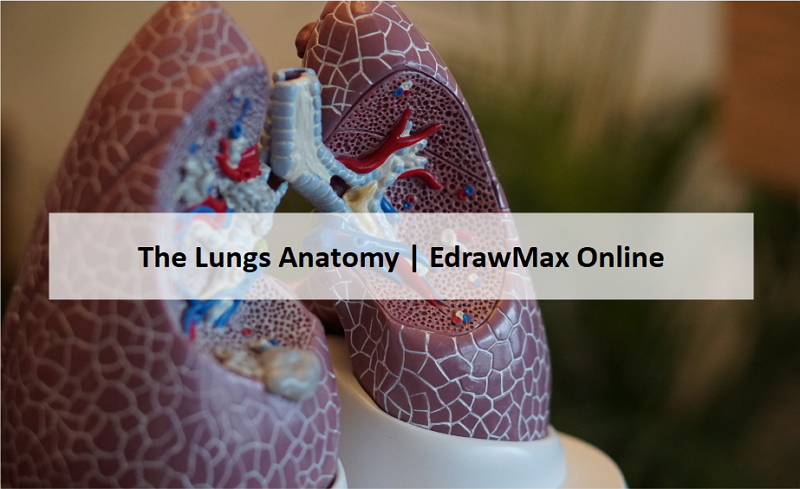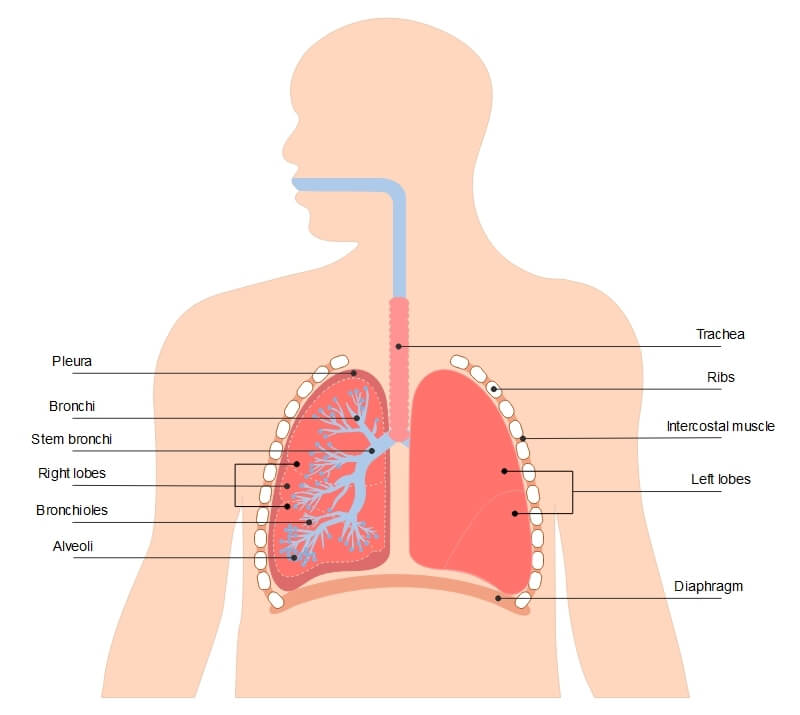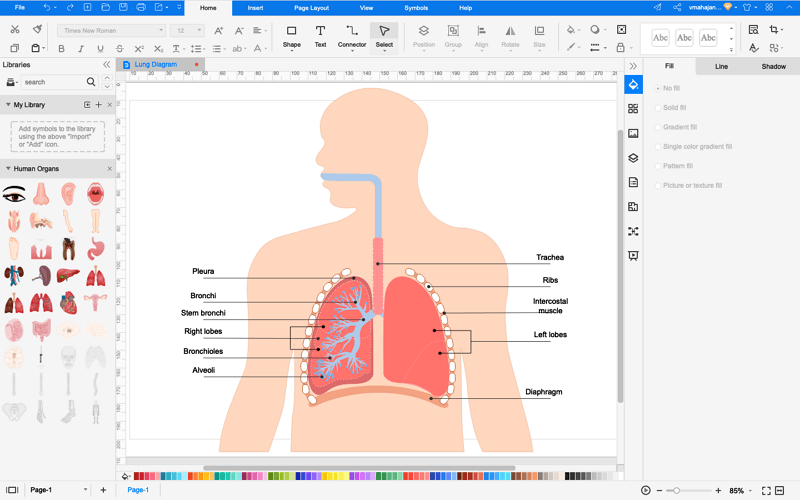A Guide to Understand Lungs with Diagram
The lung is a cone-shaped organ present in the chest cavity, helping in the gaseous exchange in the human body. Learn how to read and draw a lung diagram through this article.
1. Introduction of Lungs
The Lungs are cone-shaped organs lying in the thoracic cavity of the human body. The base of the lungs is there on the diaphragm. It helps in the gaseous exchange of the human body and removes the waste of carbon dioxide through the nose.
For a healthy human body, oxygen supply to various organs and carbon dioxide removal is a must. The lungs participate in this gaseous exchange. To learn the lung anatomy and its function, the students can use the lung diagram. As it can be tough to create a lung diagram by hand, the students can use the EdrawMax Online tool.

2. The Lungs Anatomy
How does the lung look like, or what is the structure of lung. In this part, it will give you a detailed introduction of lung structure. The Lung structure consists of:
- Apex: There is a blunt end at the superior part of the lung, which is called the Apex. It is there on the floor of the neck, above the level of the first rib.
- Base: The base is the inferior surface of the lung resting on the diaphragm.
- Lobes (two or three): The fissures on the lungs separate them into lobes. The right lung has three lobes (superior, middle, and inferior), while the left has two (superior and inferior). The lobes of the right lung are divided by fissures, namely oblique and horizontal fissures. An oblique fissure separates the lobes of the left lung.
- Surfaces (three): Lung has three surfaces, namely, costal, mediastinal, and diaphragmatic. These surfaces correspond to one particular thoracic area. The hilum of the lung is there on the mediastinal surface. The diaphragmatic surface makes the base of the lungs. The coastal surface separates the ribs and intercostal muscles.
- Borders (three): The lungs' anterior, inferior, and posterior edges are called the borders. The convergence is present in the mediastinal and costal surfaces from the anterior border. The posterior junction of mediastinal and costal surfaces makes the posterior border. The inferior border separates the base of mediastinal and costal surfaces.
- Bronchial Tree: The bunch of passages supplying air to the alveoli is called the bronchial tree. It has its branches to the left and right bronchus, starting from the trachea. Inside the lungs, the bronchus forms lobar bronchus for the supply in the lobes.
- Vasculature: The deoxygenated blood enters the lungs through the pair of pulmonary arteries. After receiving the oxygen, the blood leaves the lungs by the two pairs of pulmonary veins. The bronchial arteries are responsible for the blood supply in the bronchi, lung roots, visceral pleura, and lung tissues. In venous drainage, the right and left bronchial veins drain into the azygos and accessory hemiazygos veins, respectively.
- Nerve Supply: The nerve supply of the lungs includes parasympathetic, sympathetic, and visceral afferent fibers.

3. How Does The Lungs Work
The respiratory system starts with the inhaling of the air. After breathing, the air enters the nose and mouth. Then it travels through the throat to reach the trachea. It then enters the main bronchi of the lungs, then further branched into small bronchi and bronchial tubes.
The capillaries of alveolus participate in the exchange of oxygen and carbon dioxide. The heart sends carbon dioxide mixed blood to the lungs. When blood passes through capillaries, the alveoli take the carbons and diffuse oxygen into them.
The oxygenated blood then gets back to the heart from the lungs, and then the heart pumps it to the different organs. The lungs remove the carbon dioxide from the nose by exhaling. Creating a knee anatomy diagram by hand can be challenging. Hence, the students must use the EdrawMax Online tool. They need to follow simple steps to create a high-quality knee anatomy diagram.
4. How to Draw Lungs Diagram
There are two ways to create a lung diagram, one is by hand, and another is by using EdrawMax Online, the easiest diagramming tool.
4.1 How to Draw Lungs Diagram from Sketch
To learn about the lungs, the students must use the lung diagram. Creating the lung diagram by hand can be difficult, and the students may fail to generate a satisfactory result. Here are a few steps which the students can follow to create a lung diagram:
Step 1: To draw the windpipe, the students need to draw a vertically curved line with divergent ends and a small oval shape on its top.

Step 2: Next, they need to draw two curved lines at the divergent ends of the previously drawn line, which go out on both of its sides. The students must create bands on these lines to create the bronchi.

Step 3: Then they have to make two irregular shapes at the end of those bronchi, one at each end.
Step 4: After that, they need to branch out curved lines to create bronchioles.

4.2 How to Draw Lungs Diagram Online
However, making a lung diagram can be difficult and time-consuming. To avoid the hassle, the students must use the EdrawMax Online tool. The tool comes with an easy-to-use interface for the students who can work on it comfortably. Here are a few tips that the students can follow:
Step 1: EdrawMax Online tool is easy to use, and the students can create a high-quality diagram on this tool. To start with their lung diagram, the students need to open New on the EdrawMax Online tool. Then they have to click on the Science and Education or the Science Illustration option.
 Source:EdrawMax Online
Source:EdrawMax Online
Step 2: The students can make several types of science diagrams on this tool. To get the lung diagram, they need to go to the human anatomy option. They can find the lung diagram in this tab.

Step 3: They can take the image and then edit it out as per their choice. It can help to make a high-quality lung diagram.

Step 4: Once it completes, they can save the diagram in multiple formats and export it to use in their projects or dissertation papers.

5. Tips for Keeping Healthy Lungs
Why are lungs essential?
The organs in the human body require oxygen for their daily functions. Hence for healthy body, oxygen is a must. At the same time, they generate carbon dioxide as a waste product. Human lungs are designed to do the gaseous exchange by inhaling oxygen and exhaling carbon dioxide.
How to keep your lungs healthy?
Lung infection can be fatal, and hence the patient should visit the doctor for a check-up if they feel any discomfort while breathing. Here are a few tips for patients to keep their lungs healthy:
- Quitting smoking and avoiding the chances of passive smoking
- Avoiding the outdoors if the air pollution level is higher, using masks while being outside.
- Checking the indoors for mold and using an air purifier.
- Cleaning the dust and furs from the rooms where the pets stay.
- Using alcohol-based hand sanitizers and washing hands regularly
- Staying healthy by exercising and good habits.

6. Conclusion
As lungs play a significant role in gaseous exchange in the body, it is necessary to take care of the lungs. The students must understand lung anatomy to keep their lungs healthy. To study the lungs, they may use a lung diagram. Making a lung diagram may be time-consuming, and the students may not get satisfactory results. They must use the EdrawMax Online tool for creating their high-quality lung diagram for projects and lessons.
In conclusion, EdrawMax Online is a quick-start diagramming tool, which is easier to make artery and vein diagram and any 280 types of diagrams. Also, it contains substantial built-in templates that you can use for free, or share your science diagrams with others in our template community.




